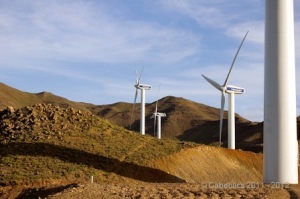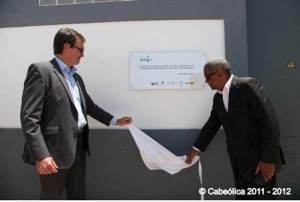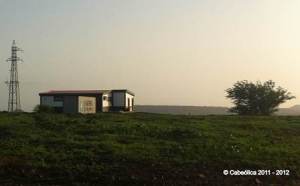 The archipelago of Cape Verde offers, as well as wonderful landscapes, one of the best locations for wind energy production. Is an area with constant wind velocity of 10 m/s. In 1994 wind power was first introduced and provided so far only 2% of the country’s energy needs. Cape Verde is a country dependent on imported fuel that besides polluting is costly and sensitive to price fluctuations and transported between islands can become a challenge. The power supply has been unstable, and the inhabitants used to cope with regular power cuts.
The archipelago of Cape Verde offers, as well as wonderful landscapes, one of the best locations for wind energy production. Is an area with constant wind velocity of 10 m/s. In 1994 wind power was first introduced and provided so far only 2% of the country’s energy needs. Cape Verde is a country dependent on imported fuel that besides polluting is costly and sensitive to price fluctuations and transported between islands can become a challenge. The power supply has been unstable, and the inhabitants used to cope with regular power cuts.
Finally in early 2011, after a decade of groundwork, the construction of the wind farms has started on four of the islands of Cape Verde. This project, owned by Cabeólica, consists of four wind farms on the islands of Boa Vista, São Vicente, Sal and Santiago, with a total of thirty wind turbines, spread over the four islands, with capacity to produce up to 25.5 MW of renewable energy and to benefit nearly 95% of 425,000 inhabitants.
The project fits into the strategy of the Cape Verdian government to increase the share of renewable energies in the archipelago to 25% by 2011 and to 50% by 2020.
This project was developed by all the 5 investors Infraco Ltd., AFC, Finnfund, Government of Cabo Verde and Electra, as a public-private partnership with the government of Cape Verde and Electra (national power utility). The project of 65 million Euros was financed with equity from InfraCo Africa, Finnfund and the African Finance Corporation, and debt financing provided by the European Investment Bank and the African Development Bank.
This project was awarded the 2011 Best Renewable Project in Africa at the Africa Energy Awards. The Cape Verde based project was singled out for being the first commercial scale Public Private Partnership (PPP) wind farm in Sub-Saharan Africa.
This project is unique in the region and following I present some of the reasons why:
- Being the first commercial scale project of its type it required a sophisticated adaptation of the usual Project Finance models to the local regulatory framework.
- Received great interest from investors and lenders mostly due to the sudden propelling of the country into a leadership position in wind power generation in the region.
- Because it of the kind of financing it was seeking, the project looked to set the highest possible environmental assessment standards, and in doing so, went well beyond local requirements; including conducting stakeholder meetings prior to submission of the EIA (not required by Cape Verdian legislation) and creating a thorough Environmental and Social Management Plan for the 20 years of envisioned lifetime. This ESMP includes the generous integration of various conservation and educational programs beyond the immediate responsibility of the company. The work conducted for our EIA was featured in a presentation during a BWEA conference.
For the successful development of this project there were some technical challenges that needed to be overcome. As already mentioned the project is divided in four islands meaning that the integration of the wind power is done to four different grids, each with its own complex issues. In order to understand the restrains it was conducted a dynamic power analysis to the four different grids.
Another important challenge is to be able to overcome grid limitations, as we are talking of four small and isolated grids and in some cases with very old equipment and without any dispatch center.
 While Government and Electra are struggling to gather the conditions to implement an automatic dispatch center and to modernize the grid infrastructure, personnel capacitating have been a very important piece to minimize the constrains as this project was for the first time contemplating migration from almost 100% diesel to a wind/diesel mix.
While Government and Electra are struggling to gather the conditions to implement an automatic dispatch center and to modernize the grid infrastructure, personnel capacitating have been a very important piece to minimize the constrains as this project was for the first time contemplating migration from almost 100% diesel to a wind/diesel mix.
To ensure the success of this project the developers of Cabeólica has engaged third-party specialists including world leaders in wind analysis: RISO and consultancy SKM, CME, Megajoule, etc….
 On April 20th of 2012 was inaugurated the last and smallest wind farm, three turbines, on the island of Boa Vista and participated in the event the Prime Minister Dr. José Maria Neves, Minister of Industry and Energy Dr. Humberto Brito, project partners and other guests.
On April 20th of 2012 was inaugurated the last and smallest wind farm, three turbines, on the island of Boa Vista and participated in the event the Prime Minister Dr. José Maria Neves, Minister of Industry and Energy Dr. Humberto Brito, project partners and other guests.
In four inaugurations chaired by Mr. Prime Minister the common denominator of his speech was the concern demonstrated by the Government about the importance for Cape Verde to have access to cheaper energy and clean. The lack of water and electricity and the high price has been a major obstacle for economic development and employment creation and thus one of the main reasons for the exodus of the population.
Although tourism has been increasing over the past decades, and Cape Verde can already count with large international tourism chains, is the population common sense that there could be more foreign investment in this area if the country could offered better conditions (energy and water) that not only would help to increase the tourism as to increase the jobs. It is now still a reality that many Cape Verdian continue to leave the country in search of employment and a brighter future.
Successful completion of this project, which was extremely challenging in terms of construction by a variety of reasons: constant winds, bureaucratic and logistical difficulties, lack of local material resources, etc., was only made possible by the high commitment and professionalism of everyone involved, being very important the continued support by the government in expediting the process.
The project was built under an EPC contract by the world’s leading manufacturer, Vestas, and counted with the participation of several Portuguese and Spanish companies.
 It was very rewarding for me to have taken part in this project in which I had the opportunity to know an amazing country, of unique characteristics, and whose people know how so well receive those coming from outside, while also having the opportunity to work with global companies and professionals with wide experience in the development and implementation of renewable projects.
It was very rewarding for me to have taken part in this project in which I had the opportunity to know an amazing country, of unique characteristics, and whose people know how so well receive those coming from outside, while also having the opportunity to work with global companies and professionals with wide experience in the development and implementation of renewable projects.
My contribution to this project was to monitor, on behalf of the owner (Cabeólica) the execution and performance of the EPC contract between the Cabeólica and Vestas, as being outsourced as the resident engineer by Cabeólica.
My primary role was to monitor the construction of the wind project on behalf of the owner. This involves oversight of an EPC, preserve Owner’s rights and manage risks and Owner obligations. This includes the coordination of the review and comment of detailed EPC contractor engineering drawings, specifications and document submittals.
Overall management responsibility over worksite safety to ensure an accident free project.
Reviewing, monitoring and assessing the contractor’s compliance with the technical specifications. Ensure Contractor compliance with QA/QC obligations under the associated contract. Manage completion and testing of the facility in accordance with the Power Purchase Agreement and associated contracts. Lead the hiring of Owner’s field staff, as required, to ensure adequate resources are in place for effective and timely execution of the projects.
I have also aided with Environmental and Health and Safety monitoring during construction and helped Cabeólica in implementing its Health and Safety Policies and Regulations.
Currently completed the construction of all wind farms and all in operation phase, Cabeólica is selling the produced energy to the national power utility, representing about a quarter of the electrical power in the country.
 The remaining generation capacity is based on diesel engines. The project gave to four islands a hybrid wind-diesel power system, with high penetration levels. It has been already registered 50% penetration of wind power on the island of Sao Vicente.
The remaining generation capacity is based on diesel engines. The project gave to four islands a hybrid wind-diesel power system, with high penetration levels. It has been already registered 50% penetration of wind power on the island of Sao Vicente.
”The large proportion of wind power makes management difficult. Together with our customer Electra, we are now concentrating on optimizing the power supply so that the grid remains stable while obtaining the maximum benefit from the wind farms,” says the CEO of Cabeólica Herkko Lehdonvirta.
Providing about 25% of the energy of this country and contributing to a reduction of the cost of the power generation by approximately 20%, Cabeólica should be proud for the great significance and impact of this project, for all Cape Verdeans who can count now with a better quality of living through more and better access to energy and also water, which is produced by desalting, to which energy is needed.
 Finally I would like to share it was for me an honor be able to contribute in a project of such importance and relevance as this for the economy and quality of life of all Cape Verdian.
Finally I would like to share it was for me an honor be able to contribute in a project of such importance and relevance as this for the economy and quality of life of all Cape Verdian.
Patricia Santos
http://www.linkedin.com/in/coachpatricia
Portuguese version of the article
http://www.portal-energia.com/desafios-e-oportunidades-no-aproveitamento-eolico-em-cabo-verde/
Filed under: Clientes, Energia Eolica, Negócios, Projectos, Wind Power | Tagged: AFC, AfDB, Africa, Cabeolica, company, desafio, eólico, Eleqtra, energia, engineer, Finnfund, Gestão, história, Infraco, Maximizar, noticia, PACGER, produção, projecto, renewable, renovavel, renováveis, success, sucesso, Vestas, wind | Leave a comment »


 Fixação da objectivos é tão importante na vida pessoal como na empresarial. O denominador comum em toda a literatura de auto-ajuda é a importância da definição de objectivos. Nós somos motivados a definir objectivos de longo prazo, objectivos de curto prazo, objectivos de vida e objectivos pessoais.
Fixação da objectivos é tão importante na vida pessoal como na empresarial. O denominador comum em toda a literatura de auto-ajuda é a importância da definição de objectivos. Nós somos motivados a definir objectivos de longo prazo, objectivos de curto prazo, objectivos de vida e objectivos pessoais.